POINTS OF CONVERGENCE
By Andrew Maerkle
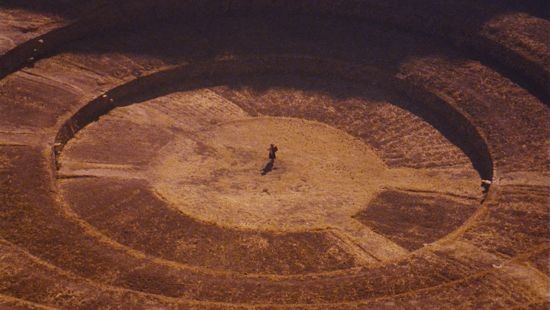 Still from Thread Routes – Chapter 1 (2010), 16mm film transferred to HD format, 29 min 31 sec, sound. All images: Courtesy of Kimsooja Studio.
Still from Thread Routes – Chapter 1 (2010), 16mm film transferred to HD format, 29 min 31 sec, sound. All images: Courtesy of Kimsooja Studio.In 1999, in Tokyo’s bustling Shibuya neighborhood, Kimsooja produced the first in a series of performance videos collectively titled A Needle Woman (1999-2001). Standing still in the middle of the oncoming crowds, the artist achieved a minimal but not insignificant intervention into the rhythm of local daily life. Simultaneously confrontational and vulnerable, her action opened a window onto the collective humanity of the passersby – viewed from the advantage of hindsight, it is perhaps they who were the vulnerable ones that day. The first version of A Needle Woman eventually led Kimsooja to make similar performances in seven other international metropolises, while in 2005 she revisited the piece by traveling to an additional six zones of conflict and social tension, among them Jerusalem, N’Djamena and Patan.
A Needle Woman is part of a larger body of work investigating themes ranging from memory and form to nature and consciousness. Often invoking images related to fabric – namely, the Korean bottari cloth bundle, but also threads and needles – such works ask viewers to reconsider their bodily relations to social structures, and reflect about what it means to be both an individual and a member of a community. Realized and exhibited in cities across the world, they offer a universal perspective, but also reflect the unique conditions of specific times and places.
ART iT met with Kimsooja in Tokyo to discuss her practice to date and how she relates to issues of globalism, locality and site-specificity.
I. Other-Self-World
Kimsooja on art as a methodology of living in the age of globalization.
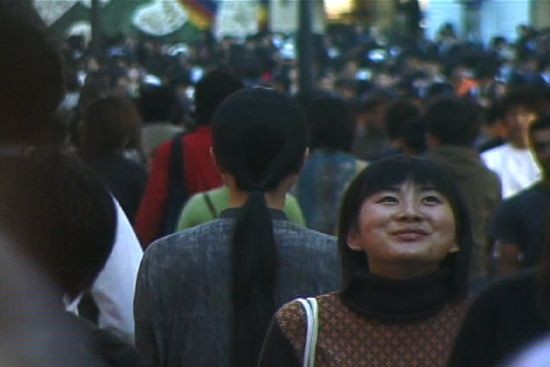 Video still (Tokyo, Japan) from A Needle Woman (1999-2001), 8-channel video projection, 6:33 min loop, silent. Collection National Museum of Contemporary Art, Korea.
Video still (Tokyo, Japan) from A Needle Woman (1999-2001), 8-channel video projection, 6:33 min loop, silent. Collection National Museum of Contemporary Art, Korea.ART iT: You’ve done projects in cities around the world, ranging from Lagos and Delhi to New York, Paris and Tokyo. Given that experience, what does locality mean to you, and has its significance for you changed over time?
Kimsooja: First of all, I must say that I was never interested in globalism and that was not my starting point for traveling around the world doing site-specific performances and video pieces. I was mostly interested in locality. In the mid-1990s my Cities on the Move-2727km Bottari Truck (1997) performance video piece coincided with the emergence of global issues in the international art scene, and my work received exposure in the context of globalism from curators who were trying to understand the phenomenon as it relates to contemporary art. However, as an artist, I was only focused on each city and its own locality. I valued the beauty of the pure authenticity and reality of each city.
I have witnessed the development and transformation of many metropolises over the years. When I visited Lagos in 2000, the city had very tough living conditions, yet maintained authentic cultural realities. Now I hear the rough areas have been smoothed out and completely developed. For example, there was the Oshodi open-air marketplace that had been established along active railway tracks, which stretched for miles almost to the horizon. When a train arrived, people selling goods on the railway tracks would immediately clear out and then return once the train had passed. The marketplace was constantly moving and taking on different forms and dynamics. If it rained, the sellers would still stand there with their goods, even when the water reached their knees. It was the most amazing marketplace I had ever seen, and I’ve always wanted to return there to work again, but I hear now the market no longer exists as before. I understand that for the local economy it might be more productive to be modernized, but in terms of the authenticity of the local way of living and culture, I think it’s a shame. With globalization, everything has become so standardized.
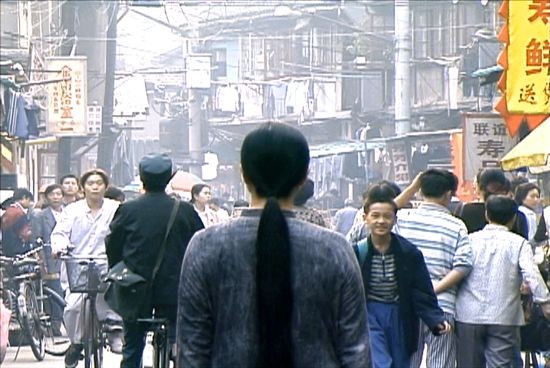 Video still (Shanghai, China) from A Needle Woman (1999-2001), 8-channel video projection, 6 min 33 sec loop, silent. Collection National Museum of Contemporary Art, Korea.
Video still (Shanghai, China) from A Needle Woman (1999-2001), 8-channel video projection, 6 min 33 sec loop, silent. Collection National Museum of Contemporary Art, Korea.ART iT: What was the impetus for you wanting to make the video pieces in different cities?
Kimsooja: The motivation began with the A Needle Woman performance I did in Tokyo in 1999 for a commission by CCA Kitakyushu. I was thinking of doing a walking performance piece, but didn’t have a definite idea, so I walked around the city waiting to find the right moment and energy in the right place. After walking for several hours I arrived at Shibuya. When I saw the hundreds and thousands of people coming and going, I was so overwhelmed that I couldn’t walk any further and had to stop there immediately, hearing my own silent inner scream right at that moment. Once I stopped, I also realized the meaning of walking.
I asked the videographer to film me from behind. At the beginning of the performance it was very difficult to stand in the middle of a crowded street with all the people’s energy coming toward me. I was determined to stand still; at the same time, I was in a vulnerable situation. I was totally exposed, but as time passed, I found my own center. I became very focused and entered a meditative state. As I stood there, I felt myself begin to mentally embrace and wrap the people who were passing me. I entered a state of mind of total concentration and peace, which allowed me to experience a certain kind of enlightenment. When I looked at the horizon of the waves of oncoming people, I could see a bright light coming from beyond them, and I found myself looking at the entire humanity of the world.
From this special experience, I determined to continue making A Needle Woman performances around the world in order to meet, possibly, every single person in the world. That was the starting point. For the first version of A Needle Woman (1999-2001), I was interested in major metropolises where I could meet many people on the street. In addition to Tokyo, I made performances in Shanghai, New Delhi, Mexico City, Lagos, Cairo, London and New York.
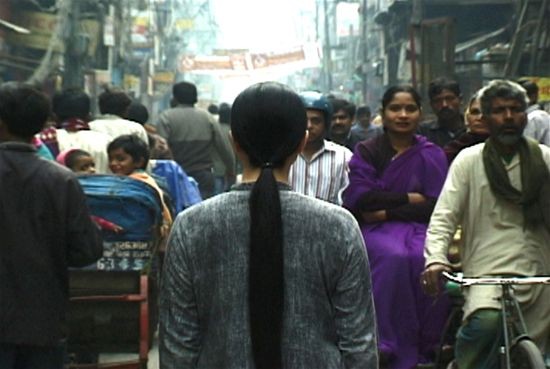 Video still (New Delhi, India) from A Needle Woman (1999-2001), 8-channel video projection, 6 min 33 sec loop, silent. Collection National Museum of Contemporary Art, Korea.
Video still (New Delhi, India) from A Needle Woman (1999-2001), 8-channel video projection, 6 min 33 sec loop, silent. Collection National Museum of Contemporary Art, Korea.ART iT: You’ve spoken about the needle as a hermaphroditic tool that is both aggressive and passive. To stand in the middle of the crowd is both a vulnerable and a confrontational action, all the more so in a city where you’re not a local. Is the confrontation an important part of the work?
Kimsooja: Every performance is a confrontation, both with one’s self and the other. In this performance, the confrontation moved from the people on the street to myself and then slowly extended to the whole world, until ultimately I achieved a level of compassion whereby self and other became one. During the performances, these transformations were happening in my mind rather than in my body.
Of course, there were many different physical reactions from the different cities. Tokyo was the most critical experience I had – people in Tokyo were aware of others next to them, but they pretended not to see them. When you see the video from Tokyo, my body is there, but it seems as if I myself am not there. I am totally ignored or isolated from the crowd, as they don’t pay attention to me or acknowledge my presence. I’m an invisible person, yet this is one of the most crowded streets in the world. The time-based video makes apparent this phenomenon. It’s as if I am a ghost, or my body becomes increasingly transparent. It’s also interesting how my state of mind changed during the course of the performance, because the more I embraced the people into my mind, the more I was also liberated from them, and could empty myself. The visual and physical processed and the psychological, spiritual process were moving in opposite directions.
Your comment on confrontation interests me not only in regard to my performance pieces but also in regard to earlier sewing pieces and installations. These were also very much related to a confrontation with “the other,” through the medium of the canvas.
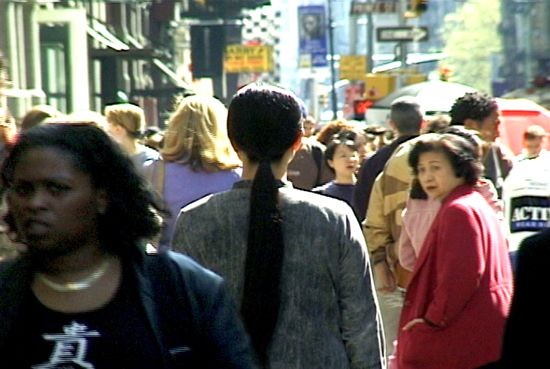 Video still (New York, USA) from A Needle Woman (1999-2001), 8-channel video projection, 6 min 33 sec loop, silent. Collection National Museum of Contemporary Art, Korea.
Video still (New York, USA) from A Needle Woman (1999-2001), 8-channel video projection, 6 min 33 sec loop, silent. Collection National Museum of Contemporary Art, Korea.ART iT: How did the experience change from city to city? Did you see different things about yourself in different cities?
Kimsooja: Yes. It depended on the location and the energy of the place. In New Delhi, people found an Asian woman standing in the middle of the street to be very odd and mysterious, perhaps because of their associations with religious imagery in Indian culture. They would stop and look at me for a few minutes, trying to find out who I was and what I was doing. Some people would ask the camera crew whether I was a Buddha or a sculpture.
During the performances, I never engaged anybody in a direct gaze. I would focus on a single, vanishing point. This helped to keep myself stable, although I knew what was happening and how people looked at me. In New Delhi, the inner gazes shared between my mind and their minds were very intense. In Shanghai, people were only half-interested and would quickly return to their own business after glancing at me. In Cairo, people were playful and curious. Some people would stand in front of me, mirroring my position for a few minutes. There was also a man who brought a bottle of cologne and sprayed it in front of me to get my attention, and a woman who grabbed my ponytail and move it around my body. The reactions tended to be direct and very provocative.
In New York, people were always interested in looking all around, searching for new information on the street, so their heads were constantly moving – eating, walking, talking, laughing, sometimes mimicking me. In London, where there is a similar multinational population, they were more turned in on themselves, and their gazes tended to be directed downwards at a 45-degree angle, rather than looking up. So these performances gave me insight into the mentality of the people in each city and different cultures in various geographies.
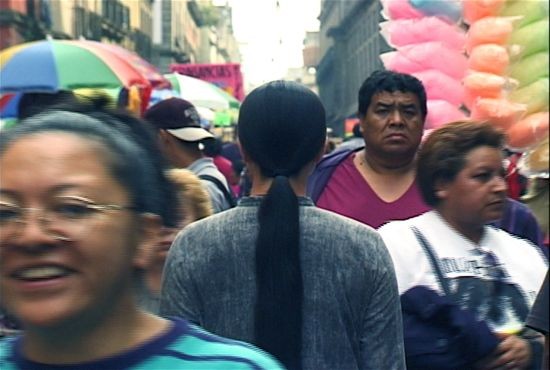 Video still (Mexico City, Mexico) from A Needle Woman (1999-2001), 8-channel video projection, 6 min 33 sec loop, silent. Collection National Museum of Contemporary Art, Korea.
Video still (Mexico City, Mexico) from A Needle Woman (1999-2001), 8-channel video projection, 6 min 33 sec loop, silent. Collection National Museum of Contemporary Art, Korea.ART iT: Have you ever done A Needle Woman or a similar kind of performance in Korea?
Kimsooja: No. I didn’t want to position myself in the same place where I’ve lived for over 40 years. I wanted to have a degree of separation from and objectivity to the cities where I performed. Had I done it in Korea, everything would have been too familiar, with less tension. It would have been difficult to create a distinction between my body and the others – even if there were a visible distinction – because mentally and historically we share so much together. This was a piece that had to be examined outside of my own context.
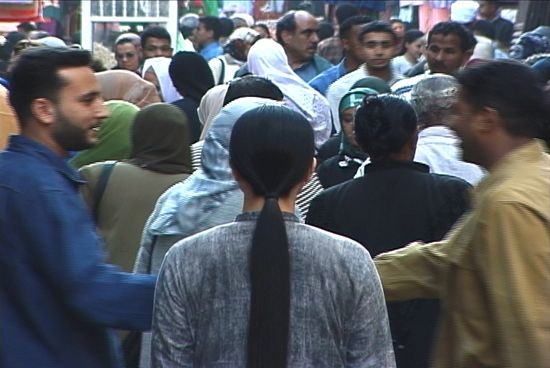 Video still (Cairo, Egypt) from A Needle Woman (1999-2001), 8-channel video projection, 6 min 33 sec loop, silent. Collection National Museum of Contemporary Art, Korea.
Video still (Cairo, Egypt) from A Needle Woman (1999-2001), 8-channel video projection, 6 min 33 sec loop, silent. Collection National Museum of Contemporary Art, Korea.ART iT: But you have done other projects and of course exhibitions in Korea, such as the Earth – Water – Fire – Air (2010) installation of videos along the breakwater of the Yeonggwang Nuclear Power Plant. What is your relationship – through your creative process – with Korea?
Kimsooja: Passions and troubles can feed creativity. All my problems are good resources. My private life, my family, my friends, my country – cultural, political and social relationships can all be material for me to work with. The more I know my own culture, the more I actually feel estranged from it because I know where it comes from and yet I know that I’m not fully part of it. It was interesting for me to have grown up in a society that was undergoing economic and political turbulence. But then I thought that living in the same homeland for about 40 years is more than enough to learn what you can from one place. I thought that if I continued to live there I would just repeat myself, and I needed another vital ground. Another factor in leaving Korea was that even until the late 1990s it was difficult for female artists to receive recognition or support in the male-dominated social hierarchy.
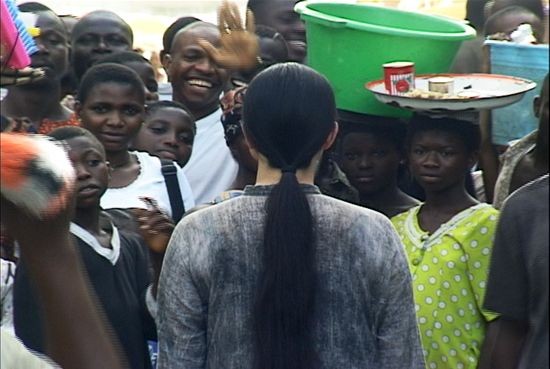 Video still (Lagos, Nigeria) from A Needle Woman (1999-2001), 8-channel video projection, 6 min 33 sec min loop, silent. Collection National Museum of Contemporary Art, Korea.
Video still (Lagos, Nigeria) from A Needle Woman (1999-2001), 8-channel video projection, 6 min 33 sec min loop, silent. Collection National Museum of Contemporary Art, Korea.ART iT: Did this idea that you were moving away from your homeland at all affect the dynamic of doing projects in other cities and countries? For example, what keeps your practice from acting out a kind of artistic globalization?
Kimsooja: I think of globalization as being related to things like the profusion of a few brands across the world, or a process in which everything becomes standardized and preexisting cultures or ways of thinking and living are slowly eradicated. My intention with A Needle Woman was more about inner experience rather than expressing myself or showing off. For me, the performance inevitably became a kind of ontological question about living in the world, and the world in which I am living became my canvas – a backdrop, rather than a market. I’ve always been interested in experiencing the wakefulness of being in the world, rather than necessarily transforming my experience for the audience. Simply, the latter came naturally as a result of my being an artist.
If there is a certain global aspect in my work, it’s perhaps more in that I present the performances together in multi-channel video installations so that viewers can simultaneously see the different momentums of each city around the world. But I don’t know if I recreate the standardized format of globalization. I am the same person and I am doing the same performance, but my inner transformation has always been there.
Is it possible for me to become a global item? I don’t know. It could be interesting if that were so. Obviously, in the current era artists can take on brand-name value. I never thought of that in my own practice because for me it’s not about the product or a work of art but the artist as a being. Art is a methodology of living for me.
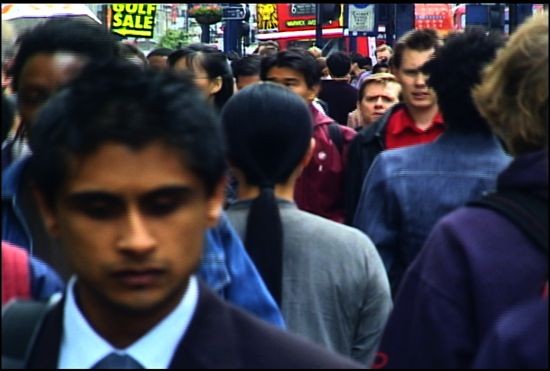 Video still (London, England) from A Needle Woman (1999-2001), 8-channel video projection, 6 min 33 sec loop, silent. Collection National Museum of Contemporary Art, Korea.
Video still (London, England) from A Needle Woman (1999-2001), 8-channel video projection, 6 min 33 sec loop, silent. Collection National Museum of Contemporary Art, Korea.ART iT: Maybe it’s no coincidence, though, that in the age of globalization we have seen a rise in site-specific commissions asking artists to fly some place, do research and produce a project in that context. Sometimes this approach can produce powerful works, but it can also become an empty gesture towards an idealized notion of locality.
Kimsooja: Yes, it is true, and depending on the practices such commissions can take shape in different ways. Performance can be very different from installation, sculpture or even painting, which normally has less site-specificity in terms of interaction and can travel anywhere. A space-oriented site-specificity will be different from a time-oriented specificity, and a politically-oriented specificity will also be different from the other two. It varies so much with each project that it’s very difficult to generalize.
Part II. Mirror-Void-Other
Kimsooja on the performance of non-action.
Kimsooja: Points of Convergence
